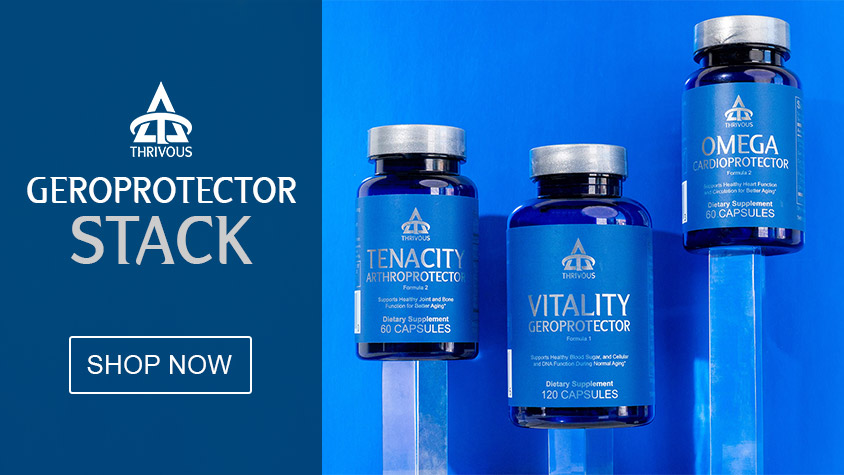What Are Geroprotectors?

Aging is an enigma that has captivated humanity throughout history. It's a pervasive biological phenomenon, characterized by a gradual decline in physical and cognitive functions, leading to increased susceptibility to disease and death. Despite our familiarity with aging, the process has remained a mystery, inspiring a relentless quest to understand and potentially control it.
Enter the world of geroprotectors. These are substances or interventions that aim to extend lifespan and improve healthspan — the period of life spent in good health — by slowing down the aging process. Geroprotectors are not necessarily about seeking immortality but primarily about enhancing the quality of life for more extended periods of time.
In this article, we will delve into the concept of geroprotectors. We will explore their history, the science behind them, their potential impact, and the challenges and ethical considerations they present. Beyond current trends or recent discoveries, we will provide a timeless understanding of geroprotectors and their evolving role in our ongoing quest to decipher and delay aging.
History of Geroprotectors
The quest for longevity is as old as human civilization itself. Throughout history, cultures around the world have been fascinated with the idea of extending life and defying aging. Ancient myths and legends often depicted gods and mythical beings possessing the secret to eternal youth. The search for the mythical "Fountain of Youth" is a testament to this age-old fascination.
As we transitioned from myth to science, the pursuit of longevity took on new forms. The evolution of geroprotectors is a relatively recent chapter in this long history.
Geroprotectors, as a concept, emerged from the scientific understanding that certain substances could potentially slow the aging process and improve healthspan. This idea was not without historical precedent. For instance, traditional Chinese medicine and Ayurveda have long utilized natural compounds with purported life-extending properties.
In the modern era, the development of geroprotectors is driven by a deeper understanding of the biological mechanisms of aging. These efforts are underpinned by a blend of ancient wisdom and contemporary scientific research.
Philosophically and culturally, the pursuit of longevity and the development of geroprotectors raise profound questions. Cultures around the world have different perspectives on aging and the desirability of extending life. Some view aging as a natural and dignified part of life, while others see it as a challenge to be overcome. The development of geroprotectors sits at the intersection of these varied viewpoints, prompting a re-examination of our relationship with aging and mortality.
The history and evolution of geroprotectors reflect a continuum from ancient lore to modern science, intertwined with deep cultural and philosophical undercurrents. As we continue to explore and develop these substances, we also navigate the complex web of human beliefs, hopes, and ethical considerations that have always surrounded the quest for a longer, healthier life.

Aging Processes
To appreciate the potential of geroprotectors, it's crucial to understand the fundamental principles of aging at the cellular and molecular levels. Aging is not just a superficial change in appearance. It's a complex biological process involving a multitude of factors at the cellular level.
One key aspect of aging is cellular senescence, a state where cells stop dividing and undergo significant changes in function and morphology. This process is often a response to DNA damage. As cells accumulate genetic damage over time, due to factors like environmental stress and normal metabolic processes, they may enter a senescent state as a protective measure against cancerous growth. However, these senescent cells can contribute to aging by secreting harmful substances that damage nearby cells and tissues.
Another critical factor in aging is oxidative stress. This occurs when there's an imbalance between the production of reactive oxygen species (free radicals) and the body's ability to detoxify these harmful compounds. Oxidative stress can damage proteins, lipids, and DNA, leading to impaired cell function. Mitochondria, the energy-producing organelles in cells, are particularly susceptible to oxidative damage, which further exacerbates the aging process.
Understanding these processes provides the theoretical foundation for the development of geroprotectors. The goal of geroprotectors is to target these underlying mechanisms of aging. By reducing cellular senescence, repairing DNA damage, mitigating oxidative stress, and improving mitochondrial function, geroprotectors could theoretically slow the aging process and improve healthspan.
In essence, the aging process is a complex interplay of various cellular and molecular phenomena. Geroprotectors aim to intervene in this intricate process, offering the promise of a healthier, more vibrant old age. As we delve deeper into the mechanisms of aging, our perception of the potential of geroprotectors continues to evolve, standing at the forefront of our ongoing quest to understand and potentially delay the biological clock.
Geroprotector Examples
The realm of geroprotectors is diverse, encompassing a wide range of substances and interventions. These can be broadly categorized into supplements, pharmaceuticals, and dietary interventions. Each category offers unique mechanisms of action and theoretical benefits, contributing to the multifaceted approach required in aging research.
Supplements
This category includes antioxidants, vitamins, and other substances found in nature that may have geroprotective effects. For example, anthocyanin, a compound found in blueberries, has been studied for its potential to protect DNA against the effects of aging. Similarly, curcumin, derived from turmeric, is being investigated for its anti-inflammatory and antioxidant properties, which could play a role in mitigating age-related decline. For more examples, see our list of 22 real anti-aging supplements.
Pharmaceuticals
These are synthetic or semi-synthetic compounds specifically designed or repurposed to target aging processes. Metformin, a drug traditionally used to treat type 2 diabetes, has garnered interest for its potential to extend lifespan by improving insulin sensitivity and reducing inflammation. Another example is rapamycin, initially developed as an immunosuppressant, which has shown promise in extending the lifespan of various organisms by inhibiting a key cellular growth pathway.
Dietary Interventions
Diet plays a crucial role in aging and longevity. Interventions like calorie restriction, intermittent fasting, and specific dietary patterns (such as the Mediterranean diet) have been associated with longer lifespans in various studies. These dietary approaches are thought to work by reducing metabolic stress on the body, thereby potentially slowing down aging processes.

Geroprotector Challenges
Despite the promise these geroprotectors hold, translating their theoretical benefits into practical, real-world outcomes remains a significant challenge. There are several reasons for this:
- Complexity of Aging: Aging is a multifaceted process influenced by a myriad of genetic, environmental, and lifestyle factors. This complexity makes it difficult to isolate the effects of specific geroprotectors.
- Long-term Studies: Researching aging requires long-term studies, often spanning several years or even decades, to accurately assess the impact of geroprotectors on lifespan and healthspan.
- Individual Variability: There is considerable individual variability in how people age and respond to geroprotectors. This variability necessitates personalized approaches to geroprotection.
Geroprotectors represent a broad and promising field in the quest to understand and potentially delay aging. However, the complexity of aging and the challenges associated with research in this area underscore the need for continued, rigorous scientific investigation to translate theory into effective aging interventions.
Ethics of Geroprotectors
The exploration of geroprotectors goes beyond the realm of biology and enters the domain of ethics, society, and philosophy. The prospect of extending human lifespan significantly raises complex questions and debates.
The development and use of geroprotectors pose ethical challenges. Key among these is the question of access and equity. If effective life-extending therapies become available, who will have access to them? There's a concern that such therapies could exacerbate social inequalities if only available to the wealthy. Additionally, there are concerns about the implications for overpopulation and resource consumption if large numbers of people live significantly longer lives.
A longer-lived population could have profound implications for society and economy. It could alter the dynamics of the workforce, retirement, and intergenerational relationships. The potential strain on healthcare systems and pension funds is also a critical concern. On the other hand, a healthier, longer-lived population could contribute to society for more extended periods, potentially leading to increased productivity and innovation.
Philosophically, the quest to delay aging prompts us to reconsider our understanding of aging itself. Is aging a disease to be combated, or is it a natural, perhaps even essential, part of the human experience? Furthermore, it raises questions about the nature of a good life. What does it mean to age well? How do notions of personal fulfillment and societal contribution evolve if our lifespan is significantly extended?
The pursuit of geroprotectors is not just a scientific endeavor but also a journey that touches upon deep ethical, social, and philosophical questions. These considerations remind us that the quest to understand and potentially delay aging is as much about our values, choices, and society as it is about our biology. As we advance in this field, it becomes increasingly important to engage in a broad, inclusive dialogue that addresses these multifaceted concerns, ensuring that the journey towards understanding and managing aging is pursued responsibly and equitably.
Geroprotector Research
The research into geroprotectors is characterized by its evolutionary and iterative nature. It's a field that continuously adapts and grows with each scientific advancement, integrating new knowledge and technologies to deepen our understanding of aging and how to potentially delay it.
The study of geroprotectors is not linear but cyclical. It involves hypothesizing, testing, observing, and then refining these hypotheses based on new evidence. As our understanding of the biological mechanisms of aging becomes more sophisticated, so too does our approach to developing and testing geroprotectors. This iterative process ensures that geroprotector research remains dynamic and responsive to new discoveries.
Advances in technology have significantly accelerated aging research. High-throughput screening methods, for instance, allow researchers to rapidly test thousands of compounds for anti-aging effects. Genomic technologies like CRISPR have opened new avenues for understanding the genetic basis of aging and identifying potential targets for geroprotectors. Artificial intelligence and machine learning are increasingly used to analyze vast datasets, predicting new geroprotector candidates and modeling their potential impacts on aging.
Aging is a complex process that intersects various fields of study. As such, geroprotector research benefits immensely from a multidisciplinary approach. Collaboration among biologists, geneticists, pharmacologists, nutritionists, and data scientists, among others, is crucial. This convergence of disciplines fosters a holistic understanding of aging, enabling the development of more effective and targeted geroprotectors.
Geroprotector research is an ever-evolving field, deeply intertwined with the latest scientific advancements and cross-disciplinary collaborations. Its timeless nature lies in its continuous adaptation and growth, reflecting the ongoing quest to understand and possibly delay the aging process. As we embrace new technologies and foster multidisciplinary partnerships, the potential for significant breakthroughs in extending healthspan becomes increasingly tangible.

Realistic Expectations
In the field of geroprotectors and anti-aging research, it is crucial to balance optimism with scientific realism. While advancements in this area offer exciting possibilities, it is important to approach them with a critical and informed perspective.
The potential of geroprotectors to enhance healthspan and delay aging is an exciting prospect. However, it's essential to ground expectations in the current state of scientific understanding. Aging is an extraordinarily complex process, and while geroprotectors show promise, their ability to significantly extend human lifespan and healthspan is still being explored. Scientific realism necessitates acknowledging the challenges and limitations of current research while remaining open to future possibilities.
There are several misconceptions about aging and geroprotectors. One common oversimplification is the idea that a single "magic bullet" can reverse or stop aging. Aging involves a myriad of biological processes, and it's unlikely that one intervention could address all of them. Additionally, the portrayal of aging as merely a disease to be cured oversimplifies the biological, social, and philosophical dimensions of aging.
In navigating the field of geroprotectors, critical thinking is essential. This involves scrutinizing the methodology and findings of research studies, understanding the difference between correlation and causation, and being aware of the potential biases in research and reporting. Consumers and enthusiasts should be cautious of sensational claims and unproven therapies, focusing instead on evidence-based information.
The journey towards understanding and potentially manipulating the aging process requires a careful balance between hope and skepticism. By maintaining realistic expectations and a critical approach to evaluating research, we can better navigate the complexities and nuances of geroprotector research, avoiding the pitfalls of misconceptions and oversimplifications. This approach will not only aid in advancing scientific knowledge but also ensure that our pursuit of longevity is both responsible and informed.
Thrivous
At Thrivous, our mission is to help you access technology with the greatest potential to improve your brain and body. To that end, we develop high quality natural geroprotector supplements. They combine nutrients and doses with the best available scientific evidence for the greatest magnitudes of effect on important aspects of healthy life extension.
- Vitality Geroprotector enhances cellular and metabolic function for better aging. Each bottle provides a month supply (60 capsules) of Berberine with Milk Thistle, Mirtoselect® Blueberry Anthocyanin, and Coenzyme Q10.
- Omega Cardioprotector enhances heart function and circulation for better aging. Each bottle provides a month supply (60 capsules) of AvailOm® Omega 3 Lysine Complex, Garlic, Gotu Kola, and Oligopin® French Maritime Pine Bark.
- Tenacity Arthroprotector enhances joint and bone function for better aging. Each bottle provides a month supply (60 capsules) of ApresFlex® Boswellia Serrata, S Adenosyl Methionine (SAMe), Turmeric Curcumin, Vitamin D3, and Vitamin K2 MK7.
- Alpha Neuroprotector enhances brain and nerve function for better aging. Each bottle provides a month supply (120 capsules) of Acetyl L Carnitine (ALCAR), Alpha GPC, Ginkgo Biloba, R Alpha Lipoic Acid, and SerinAid® Phosphatidylserine.
The benefits of each of these supplements complements the others. So Thrivous also provides a combination stack at a discounted price:
- Geroprotector Stack includes Vitality, Omega, and Tenacity.
All Thrivous formulas are completely open source. The supplement facts panel on each label fully discloses all ingredients and amounts. And we publish all quality control test results from our suppliers, manufacturing, and third parties. This is an exceptional practice among supplement vendors.
Thrivous also provides a free biological age calculator based on the PhenoAge algorithm, as well as the Thrivous Clock service to collect aging biometrics. These services help our customer monitor trends in their health, and identify effective geroprotector interventions. Among Thrivous customers who have used all Thrivous geroprotectors daily for at least 4 years, biological ages average 10.21 years younger than chronological ages.
If you’re new to geroprotectors, Thrivous is an easy and dependable way to start. If you’ve used them for years, Thrivous is a convenient base on which to build your stack. Either way, our full line of geroprotectors is now available to you online in the Thrivous store.
More Articles
Read more articles at Thrivous, the human enhancement company. You can browse recent articles in Thrivous Views. See other Geroprotectors articles. Or check out an article below.
-
Maximize Volleyball Performance with Caffeine
In the dynamic world of sports, volleyball stands out as a game of energy, precision, and agility. With its growing ...
-
Vitamin D3 May Facilitate Sustainable Healthcare
As healthcare costs and medical insurance expenses continue to escalate, innovative approaches to reducing these costs are crucial. Vitamin D ...



